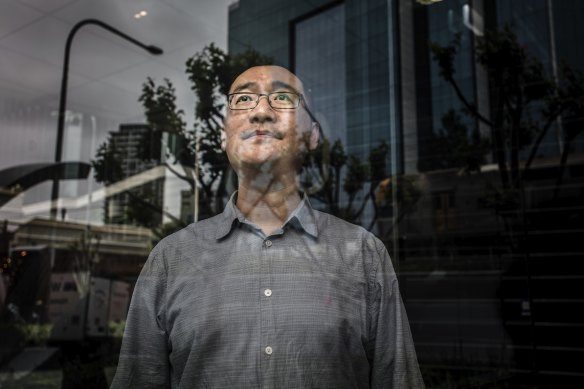By Nick Newling and Craig Butt
If you’ve ever caught the train from Killara and sat between two accountants or made small talk waiting for coffee in Parramatta to realise everyone works in IT, you might not be surprised to learn certain occupations have carved out distinct Sydney territories where they reign supreme.
From chefs in bustling Haymarket to solicitors in gentrified Newtown and carpenters along the forested riverbanks of Woronora, The Sydney Morning Herald has mapped data from the last census to identify the top job in each Sydney suburb.
The map below shows the most common job in each suburb of inner Sydney. (A more zoomed-out map showing all of Greater Sydney can be found further down in this article). Keep in mind that the map demonstrates the most common job in each suburb; it does not reflect those jobs held by the majority of workers.
The most popular job in Greater Sydney is sales assistant. It is the top job in 381 of the 562 suburbs with a working population greater than 1000 people, indicated by the sea of yellow on the above map once you leave the inner city.
Sales and marketing managers (dark blue on the map) are the most common job in 47 suburbs, including stretches of the inner south and lower northern beaches, while accountants (green) are the top occupation in 38 suburbs.
Accountants form a significant cluster along the T1 railway line from Artarmon to Wahroonga and sections of the newly opened Metro North West line in Macquarie Park and Epping.
You can see a list of the 10 most common jobs in your area – and whether yours is one of them – using our interactive. Type your job in the box below and follow the prompts to our visual story. It starts out by taking you through the typical earnings for your occupation before breaking down the top jobs in your suburb.
Solicitor territory includes affluent pockets south of the harbour between Woolloomooloo and Woollahra, between McMahons Point and Greenwich on the lower north shore, and the gentrified inner west suburbs of Stanmore and Newtown.
Sydney’s finest real estate is reserved for chief executives and managing directors, who call Balgowlah Heights, Hunters Hill, Mosman and Vaucluse home in greater numbers than people in any other job.
Another notable cluster is software engineers, who are most prominent in the suburbs of Westmead, Wentworthville, Girraween, and Parramatta.
Software engineer Lailei Huang, founder of Immersive Academy, a non-profit tech education meetup, has lived in Parramatta since 2020.

Lailei Huang: “In Parramatta, we actually put people in the centre.”Credit: Steven Siewert
Huang said the area offers a mix of the city and suburban lifestyle with a strong community focus that provides the perfect environment for his young daughter to grow up in.
“In Parramatta, we actually put people in the centre. We really [care about] people’s wellbeing, the elderly, the childcare, the kids,” he said.
“That’s what I love ... we want to hear the voice of different community groups ... [That] is a reason I like Australia. I like this culture.”
The map below shows the most common job in each suburb in Greater Sydney. Office jobs such as solicitor and sales and marketing manager have been grouped together and shaded in green.
In the lower Blue Mountains, secondary school teachers (red on the map) are the most common job. Western Sydney’s industrial hubs, centred around the Blacktown and Fairfield council areas, are home to large numbers of people working in warehouses.
Truck driving (coloured light blue) is the most common job in the suburban fringes of Silverdale, Mulgoa, Londonderry and Wilberforce.
UNSW City Futures Research Centre professor Bill Randolph said the clustering of jobs was an unintentional result of two factors: housing markets and lifestyle choices.
“If you’re a lawyer or an accountant in Sydney, you’re going to be living in a nice area, but it’s everybody else that kind of shuffles around,” he said.
Randolph said as the housing and employment markets have tightened in recent decades, lifestyle choices have played a less decisive role in an individual’s housing choices than house prices.
“Unless you start to build affordable homes in unaffordable places that polarisation can’t go backwards,” he said, noting such policies were unattractive for governments.
Another factor leading to the occupation clusters, said KPMG urban economist Terry Rawnsley, is economic corridors created by businesses themselves: Sydney has warehouses in the western suburbs, restaurants in the CBD and accountancy firms on the north shore.
Top 10 most common jobs in Greater Sydney
- Sales assistant (general) - 89,248
- General clerk - 48,980
- Accountant (general) - 44,284
- Sales and marketing manager - 38,434
- Storeperson - 36,188
- Retail manager (general) - 34,009
- Aged or disabled carer - 33,904
- Primary school teacher - 31,259
- Secondary school teacher - 31,047
- Marketing specialist - 25,451
Rawnsley said this was “a pretty normal pattern for megacities like Sydney”.
“Sydney is maybe just a touch more reinforced because of the natural geography with the harbour and the traditional CBD,” he added.
Then there is the social capital of living in desirable neighbourhoods, Rawnsley said.
“If you want to [hire] a really good barrister, the fact they live in Bondi kind of reassures you about their skills,” said Rawnsley. “If they’re living somewhere else, you might go, ‘Well, are you the best barrister?’
“It’s almost a sort of prestige address which helps reinforce your credentials in that industry.”
Rawnsley said the concentration of different jobs in different areas could mean young people are not exposed to the whole range of job opportunities available in their city.
“Forty or 50 years ago in Sydney you might have had a street where you’d have a trainee, an accountant, a nurse, a teacher, a labourer on the one street,” he said.
The Morning Edition newsletter is our guide to the day’s most important and interesting stories, analysis and insights. Sign up here.